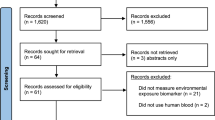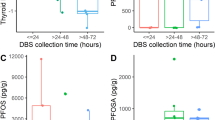Abstract
Background
Exposure–response studies and policy evaluations of household air pollution (HAP) are limited by current methods of exposure assessment which are expensive and burdensome to participants.
Methods
We collected 152 dried blood spot (DBS) specimens during the heating and non-heating seasons from 53 women who regularly used biomass-burning stoves for cooking and heating. Participants were enrolled in a longitudinal study in China. Untargeted metabolic phenotyping of DBS were generated using ultra-high performance liquid chromatography coupled with mass spectrometry to exemplify measurement precision and assessment for feasibility to detect exposure to HAP, evaluated by season (high pollution vs. low pollution) and measured personal exposure to fine particulate matter <2.5 μm diameters (PM2.5) and black carbon (BC) in the 48-h prior to collecting the DBS specimen.
Results
Metabolites e.g., amino acids, acyl-carnitines, lyso-phosphorylcholines, sphinganine, and choline were detected in the DBS specimens. Our approach is capable of detecting the differences in personal exposure to HAP whilst showing high analytical reproducibility, coefficient of variance (CV) <15%, meeting the U.S. Food and Drug Administration criteria.
Conclusions
Our results provide a proof of principle that high-resolution metabolic phenotypic data can be generated using a simple DBS extraction method thus suitable for exposure studies in remote, low-resource settings where the collection of serum and plasma is logistically challenging or infeasible. The analytical run time (19 min/specimen) is similar to most global phenotyping methods and therefore suitable for large-scale application.
This is a preview of subscription content, access via your institution
Access options
Subscribe to this journal
Receive 6 print issues and online access
$259.00 per year
only $43.17 per issue
Buy this article
- Purchase on Springer Link
- Instant access to full article PDF
Prices may be subject to local taxes which are calculated during checkout



Similar content being viewed by others
References
Mehta S, Shin H, Burnett R, North T, Cohen AJ. Ambient particulate air pollution and acute lower respiratory infections: a systematic review and implications for estimating the global burden of disease. Air Qual Atmos Health. 2013;6:69–83.
Smith KR, McCracken JP, Weber MW, Hubbard A, Jenny A, Thompson LM, et al. Effect of reduction in household air pollution on childhood pneumonia in Guatemala (RESPIRE): a randomised controlled trial. Lancet. 2011;378:1717–26.
Lee MS, Hang JQ, Zhang FY, Dai HL, Su L, Christiani DC. In-home solid fuel use and cardiovascular disease: a cross-sectional analysis of the Shanghai Putuo study. Environ Health A Glob Access Sci Source. 2012;11:18.
Collaborators GBDRF. Global, regional, and national comparative risk assessment of 84 behavioural, environmental and occupational, and metabolic risks or clusters of risks for 195 countries and territories, 1990–2017: a systematic analysis for the Global Burden of Disease Study 2017. Lancet. 2018;392:1923–94.
Clark ML, Peel JL, Balakrishnan K, Breysse PN, Chillrud SN, Naeher LP, et al. Health and household air pollution from solid fuel use: the need for improved exposure assessment. Environ Health Perspect. 2013;121:1120–8.
Ezzati M, Baumgartner JC. Household energy and health: where next for research and practice? Lancet. 2017;389:130–2.
McDade TW, Williams S, Snodgrass JJ. What a drop can do: dried blood spots as a minimally invasive method for integrating biomarkers into population-based research. Demography. 2007;44:899–925.
George RS, Moat SJ. Effect of dried blood spot quality on newborn screening analyte concentrations and recommendations for minimum acceptance criteria for sample analysis. Clin Chem. 2016;62:466–75.
Wang Q, Sun T, Cao Y, Gao P, Dong J, Fang Y, et al. A dried blood spot mass spectrometry metabolomic approach for rapid breast cancer detection. OncoTargets Ther. 2016;9:1389–98.
Hu Z, Zhu Z, Cao Y, Wang L, Sun X, Dong J, et al. Rapid and sensitive differentiating ischemic and hemorrhagic strokes by dried blood spot based direct injection mass spectrometry metabolomics analysis. J Clin Lab Anal. 2016;30:823–30.
Zhang X, Li Y, Liang Y, Sun P, Wu X, Song J, et al. Distinguishing intracerebral hemorrhage from acute cerebral infarction through metabolomics. Rev de Investigacion Clin; Organo Del Hospital de Enfermedades de la Nutricion. 2017;69:319–28.
Hofman S, Bolhuis MS, Koster RA, Akkerman OW, van Assen S, Stove C, et al. Role of therapeutic drug monitoring in pulmonary infections: use and potential for expanded use of dried blood spot samples. Bioanalysis. 2015;7:481–95.
Enderle Y, Foerster K, Burhenne J. Clinical feasibility of dried blood spots: analytics, validation, and applications. J Pharm Biomed Anal. 2016;130:231–43.
Nicholson JK, Lindon JC, Holmes E. ‘Metabonomics’: understanding the metabolic responses of living systems to pathophysiological stimuli via multivariate statistical analysis of biological NMR spectroscopic data. Xenobiotica. 1999;29:1181–9.
Holmes E, Loo RL, Stamler J, Bictash M, Yap IKS, Chan Q, et al. Human metabolic phenotype diversity and its association with diet and blood pressure. Nature. 2008;453:396–400.
Dona AC, Jiménez B, Schäfer H, Humpfer E, Spraul M, Lewis MR, et al. Precision high-throughput proton NMR spectroscopy of human urine, serum, and plasma for large-scale metabolic phenotyping. Anal Chem. 2014;86:9887–94.
Dunn WB, Broadhurst D, Begley P, Zelena E, Francis-McIntyre S, Anderson N, et al. Procedures for large-scale metabolic profiling of serum and plasma using gas chromatography and liquid chromatography coupled to mass spectrometry. Nat Protoc. 2011;6:1060–83.
Want EJ, Wilson ID, Gika H, Theodoridis G, Plumb RS, Shockcor J, et al. Global metabolic profiling procedures for urine using UPLC-MS. Nat Protoc. 2010;5:1005–18.
Caron-Beaudoin E, Bouchard M, Wendling G, Barroso A, Bouchard MF, Ayotte P, et al. Urinary and hair concentrations of trace metals in pregnant women from Northeastern British Columbia, Canada: a pilot study. J Expo Sci Environ Epidemiol. 2019;29:613–23.
Liang D, Moutinho JL, Golan R, Yu T, Ladva CN, Niedzwiecki M, et al. Use of high-resolution metabolomics for the identification of metabolic signals associated with traffic-related air pollution. Environ Int. 2018;120:145–54.
Vlaanderen JJ, Janssen NA, Hoek G, Keski-Rahkonen P, Barupal DK, Cassee FR, et al. The impact of ambient air pollution on the human blood metabolome. Environ Res. 2017;156:341–8.
Walker DI, Lane KJ, Liu K, Uppal K, Patton AP, Durant JL, et al. Metabolomic assessment of exposure to near-highway ultrafine particles. J Expo Sci Environ Epidemiol. 2019;29:469–83.
Wei Y, Shi Q, Wang Z, Zhang R, Su L, Quamruzzaman Q, et al. Maternal/fetal metabolomes appear to mediate the impact of arsenic exposure on birth weight: a pilot study. J Expo Sci Environ Epidemiol. 2017;27:313–9.
Koulman A, Prentice P, Wong MCY, Matthews L, Bond NJ, Eiden M, et al. The development and validation of a fast and robust dried blood spot based lipid profiling method to study infant metabolism. Metabolomics Off J Metabolomic Soc. 2014;10:1018–25.
Kong ST, Lin HS, Ching J, Ho PC. Evaluation of dried blood spots as sample matrix for gas chromatography/mass spectrometry based metabolomic profiling. Anal Chem. 2011;83:4314–8.
Palmer EA, Cooper HJ, Dunn WB. Investigation of the 12-month stability of dried blood and urine spots applying untargeted UHPLC-MS metabolomic assays. Anal Chem. 2019;91:14306–13.
Shan M, Yang X, Ezzati M, Chaturvedi N, Coady E, Hughes A, et al. A feasibility study of the association of exposure to biomass smoke with vascular function, inflammation, and cellular aging. Environ Res. 2014;135:165–72.
Clark SN, Schmidt AM, Carter EM, Schauer JJ, Yang X, Ezzati M, et al. Longitudinal evaluation of a household energy package on blood pressure, central hemodynamics, and arterial stiffness in China. Environ Res. 2019;177:108592.
Clark S, Carter E, Shan M, Ni K, Niu H, Tseng JTW, et al. Adoption and use of a semi-gasifier cooking and water heating stove and fuel intervention in the Tibetan Plateau, China. Environ Res Lett. 2017;12:075004.
Baumgartner J, Clark S, Carter E, Lai A, Zhang Y, Shan M, et al. Effectiveness of a household energy package in improving indoor air quality and reducing personal exposures in rural China. Environ Sci Technol. 2019;53:9306–16.
Carter E, Archer-Nicholls S, Ni K, Lai AM, Niu H, Secrest MH, et al. Seasonal and diurnal air pollution from residential cooking and space heating in the Eastern Tibetan Plateau. Environ Sci Technol. 2016;50:8353–61.
Ni K, Carter E, Schauer JJ, Ezzati M, Zhang Y, Niu H, et al. Seasonal variation in outdoor, indoor, and personal air pollution exposures of women using wood stoves in the Tibetan Plateau: Baseline assessment for an energy intervention study. Environ Int. 2016;94:449–57.
Bond T, Streets D, Yarber K, Nelson S, Woo J, Klimont Z. A technology‐based global inventory of black and organic carbon emissions from combustion. J Geophys Res Atmos. 2004;109:D14203.
Baumgartner J, Carter E, Schauer JJ, Ezzati M, Daskalopoulou SS, Valois MF, et al. Household air pollution and measures of blood pressure, arterial stiffness and central haemodynamics. Heart. 2018;104:1515–21.
Denes J, Szabo E, Robinette SL, Szatmari I, Szonyi L, Kreuder JG, et al. Metabonomics of newborn screening dried blood spot samples: a novel approach in the screening and diagnostics of inborn errors of metabolism. Anal Chem. 2012;84:10113–20.
Michopoulos F, Theodoridis G, Smith CJ, Wilson ID. Metabolite profiles from dried blood spots for metabonomic studies using UPLC combined with orthogonal acceleration ToF-MS: effects of different papers and sample storage stability. Bioanalysis. 2011;3:2757–67.
Schymanski EL, Jeon J, Gulde R, Fenner K, Ruff M, Singer HP, et al. Identifying small molecules via high resolution mass spectrometry: communicating confidence. Environ Sci Technol. 2014;48:2097–8.
Chambers MC, Maclean B, Burke R, Amodei D, Ruderman DL, Neumann S, et al. A cross-platform toolkit for mass spectrometry and proteomics. Nat Biotechnol. 2012;30:918–20.
Smith CA, Want EJ, O’Maille G, Abagyan R, Siuzdak G. XCMS: processing mass spectrometry data for metabolite profiling using nonlinear peak alignment, matching, and identification. Anal Chem. 2006;78:779–87.
FDA. Bioanalytical Method Validation Guidance for Industry. U.S. Department of Health and Human Services Food and Drug Administration, Center for Drug Evaluation and Research (CDER) in Silver Spring and Center for Veterinary Medicine (CVM) ub Rockville; 2018. https://www.fda.gov/media/70858/download.
Wheelock AM, Wheelock CE. Trials and tribulations of ‘omics data analysis: assessing quality of SIMCA-based multivariate models using examples from pulmonary medicine. Mol Biosyst. 2013;9:2589–96.
Eriksen L, Trygg J, Wold S. CV-ANOVA for significance testing of PLS and OPLS models. J Chemometrics. 2008;22:594–600.
Strumpf EC, Harper S, Kaufman JS, editors. Methods in Social Epidemioloogy, 2nd edition, 2017, Chapter 14 Fixed effects and difference-in-differences. p 341–68.
Born B, Breitung J. Testing for Serial Correlation in Fixed-Effects Panel Data Models. Econom Rev. 2016;35:1290–316.
Zukunft S, Sorgenfrei M, Prehn C, Möller G, Adamski J. Targeted metabolomics of dried blood spot extracts. Chromatographia. 2013;76:1295–305.
Vorbach C, Harrison R, Capecchi MR. Xanthine oxidoreductase is central to the evolution and function of the innate immune system. Trends Immunol. 2003;24:512–7.
Maiuolo J, Oppedisano F, Gratteri S, Muscoli C, Mollace V. Regulation of uric acid metabolism and excretion. Int J Cardiol. 2016;213:8–14.
Gold MJ, Hiebert PR, Park HY, Stefanowicz D, Le A, Starkey MR, et al. Mucosal production of uric acid by airway epithelial cells contributes to particulate matter-induced allergic sensitization. Mucosal Immunol. 2016;9:809–20.
Kitamura K, Kikuchi Y, Watanabe S, Waechter G, Sakurai H, Takada T. Health effects of chronic exposure to polychlorinated dibenzo-P-dioxins (PCDD), dibenzofurans (PCDF) and coplanar PCB (Co-PCB) of municipal waste incinerator workers. J Epidemiol. 2000;10:262–70.
Leone RD, Emens LA. Targeting adenosine for cancer immunotherapy. J Immunother Cancer. 2018;6:57.
Brauer M, Amann M, Burnett RT, Cohen A, Dentener F, Ezzati M, et al. Exposure assessment for estimation of the global burden of disease attributable to outdoor air pollution. Environ Sci Technol. 2012;46:652–60.
WHO guidelines for indoor air quality: household fuel combustion. World Health Organisation, Geneva, Switzerland. https://apps.who.int/iris/bitstream/handle/10665/141496/9789241548885_eng.pdf?sequence=1.
Baumgartner J, Schauer JJ, Ezzati M, Lu L, Cheng C, Patz JA, et al. Indoor air pollution and blood pressure in adult women living in rural China. Environ Health Perspect. 2011;119:1390–5.
Baumgartner J, Zhang Y, Schauer JJ, Huang W, Wang Y, Ezzati M. Highway proximity and black carbon from cookstoves as a risk factor for higher blood pressure in rural China. Proc Natl Acad Sci USA. 2014;111:13229–34.
Hystad P, Duong M, Brauer M, Larkin A, Arku R, Kurmi OP, et al. Health effects of household solid fuel use: findings from 11 countries within the prospective urban and rural epidemiology study. Environ Health Perspect. 2019;127:57003.
Smith KR, Bruce N, Balakrishnan K, Adair-Rohani H, Balmes J, Chafe Z, et al. Millions dead: how do we know and what does it mean? Methods used in the comparative risk assessment of household air pollution. Annu Rev Public health. 2014;35:185–206.
Acknowledgements
This work was supported by the Pump-Priming Project Grant from the MRC Centre for Environment and Health, which was funded by the Medical Research Council and Public Health England [MR/L01341X/1, 2009–2019] and is currently funded by the Medical Research Council [MR/S019669/1] and Environmental Protection Agency, US [EPA-STAR #83542201]. RLL acknowledges support from Chinese Academy of Sciences President’s International Fellowship Initiative (2018VBB0001). QWL and HT acknowledge financial supports from National Key R&D Program of China (2017YFC0906800) and Shanghai Municipal Science and Technology Major Project (2017SHZDZX01) and the National Natural Science Foundation of China (81590953, 31821002 and 21405020). QC acknowledges support from Wellcome Trust, UK [Strategic Award 100693/Z/12/Z]. JB acknowledges support from the Canadian Institutes for Health Research [244383]. EC acknowledges support from the Burroughs Wellcome Fund Collaborative Research Travel Grant [1018789]. RLL is supported by the Western Australian Government through the Premier’s Science Fellowship Program.
Author information
Authors and Affiliations
Contributions
JB, QC, and YW conceived and designed experiments; EC and SC collected data; SL performed the experiments; RLL, and QWL analyzed data; RLL and HT interpreted the results and wrote the paper; and YW, JB, EC, and QC contributed to the writing of the paper. All authors reviewed and approved the submission; and RLL and QWL contributed equally to this work.
Corresponding authors
Ethics declarations
Conflict of interest
The authors declare that they have no conflict of interest.
Additional information
Publisher’s note Springer Nature remains neutral with regard to jurisdictional claims in published maps and institutional affiliations.
Rights and permissions
About this article
Cite this article
Loo, R.L., Lu, Q., Carter, E.M. et al. A feasibility study of metabolic phenotyping of dried blood spot specimens in rural Chinese women exposed to household air pollution. J Expo Sci Environ Epidemiol 31, 328–344 (2021). https://doi.org/10.1038/s41370-020-0252-0
Received:
Revised:
Accepted:
Published:
Issue Date:
DOI: https://doi.org/10.1038/s41370-020-0252-0



